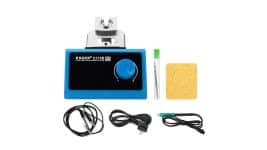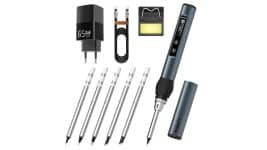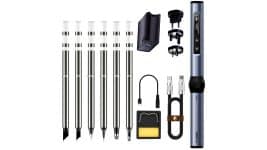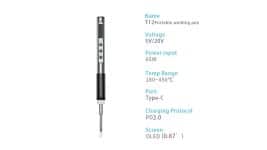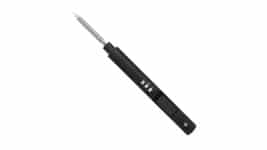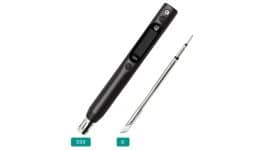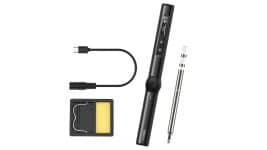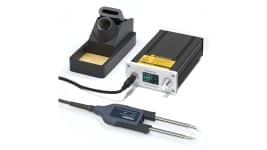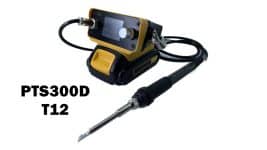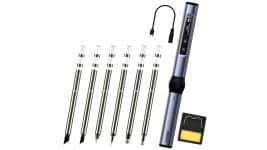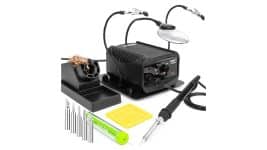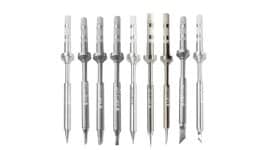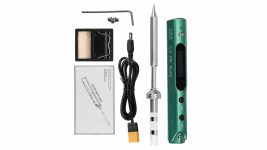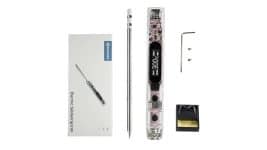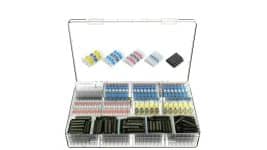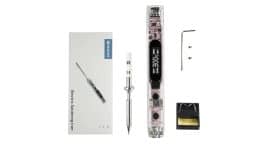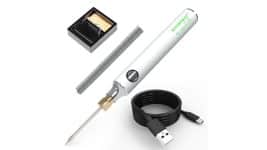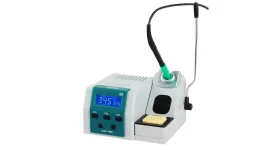Find the best deals on soldering tools with our exclusive coupon codes. From soldering irons to soldering stations, we have discounts for all types of soldering equipment. Browse our selection and find the perfect code for your needs.
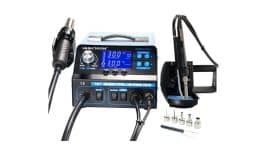
ExpiredYIHUA 992DA+ 4 in 1 LCD Hot Air Soldering Station Banggood Coupon Code [Czech Warehouse]
Soldering Iron Buying Guide
Are you looking to purchase a soldering iron but feeling overwhelmed by the choices available? Look no further! This comprehensive soldering iron buying guide is here to help you make an informed decision. Whether you’re a beginner or a seasoned professional, understanding the different types of soldering irons and the factors to consider when choosing one is essential.
In the first section of this guide, we will delve into the various types of soldering irons available in the market. From pencil irons to soldering stations, we will explore their unique features and applications. Understanding the differences between these types will allow you to select the one that best suits your specific needs.
Next, we will discuss the factors to consider when purchasing a soldering iron. These include wattage, temperature control, and tip compatibility. By evaluating these factors, you can ensure that you choose a soldering iron that provides optimal performance and meets your requirements.
In the following sections, we will explore the features and specifications of soldering irons in more detail. This will include examining the different types of tips available, the importance of ergonomics, and the overall build quality of the soldering iron. By understanding these features, you can make an informed decision and select a soldering iron that will serve you well for years to come.
Lastly, we will provide tips and guidelines for using a soldering iron safely and effectively. Soldering can be a delicate process, and it’s crucial to take the necessary precautions to avoid accidents and ensure successful soldering. We will discuss proper safety equipment, workspace setup, and techniques to achieve clean and reliable solder joints.
In conclusion, this soldering iron buying guide will equip you with the knowledge and information necessary to choose the right soldering iron for your needs. Whether you’re a hobbyist working on small electronics or a professional tackling intricate circuitry, a well-selected soldering iron can make all the difference in your projects. So, let’s dive in and discover the perfect soldering iron for you!
Understanding the Different Types of Soldering Irons
When it comes to choosing the right soldering iron, it’s important to understand the different types available and how they can melt solder with precision, like a hot knife through butter. There are primarily three types of soldering irons: pencil irons, soldering stations, and soldering guns. Pencil irons are the most common type and are suitable for general soldering tasks. They are lightweight, easy to handle, and provide precise control over the temperature. Soldering stations, on the other hand, consist of a power unit and a detachable soldering iron. They offer more advanced features such as adjustable temperature control and digital displays, making them ideal for professional use or intricate soldering projects. Lastly, soldering guns are designed for heavy-duty soldering applications. They have a pistol-like grip and a built-in transformer, allowing them to generate higher temperatures quickly. Soldering guns are commonly used for soldering thick wires or metal sheets.
Each type of soldering iron has its advantages and limitations, so it’s essential to consider your specific needs before making a purchase. If you are a hobbyist or a beginner, a pencil iron or a basic soldering station should suffice for most soldering tasks. Those who require more precision or frequently work with delicate components may benefit from investing in a high-quality soldering station with temperature control. On the other hand, if you primarily work with heavy-duty applications or thicker materials, a soldering gun would be the most suitable choice. By understanding the different types of soldering irons and their capabilities, you can make an informed decision and ensure that you have the right tool for your soldering needs.
Factors to Consider When Choosing a Soldering Iron
To make sure you choose the right tool, envision yourself holding a tool that perfectly fits in your hand and effortlessly glides over the delicate circuit board. One of the most important factors to consider when choosing a soldering iron is the wattage. The wattage indicates the power of the soldering iron and determines how quickly it can heat up and maintain a stable temperature. For general soldering tasks, a soldering iron with a wattage between 20-40 watts should be sufficient. However, if you plan on working with larger and more demanding projects, a higher wattage soldering iron may be necessary to ensure efficient and effective soldering.
Another factor to consider is the temperature control feature of the soldering iron. Some soldering irons come with adjustable temperature settings, allowing you to select the desired temperature for different soldering tasks. This can be particularly useful when working with sensitive electronic components that require precise temperature control. On the other hand, soldering irons without temperature control may be more suitable for simpler and less delicate soldering jobs.
Additionally, it is important to consider the type of tip that comes with the soldering iron. Different tips are designed for specific soldering tasks, such as fine-point tips for intricate work or chisel tips for larger solder joints. Some soldering irons offer interchangeable tips, allowing you to switch between different types depending on your needs. It is also worth considering the durability and longevity of the tip, as it can affect the overall lifespan and performance of the soldering iron.
By considering these factors, you can ensure that you choose a soldering iron that meets your specific needs and allows you to perform soldering tasks with precision and ease.
Exploring the Features and Specifications of Soldering Irons
Discover the amazing features and specifications of soldering irons that will make your soldering projects a breeze. Soldering irons come with a variety of features that can greatly enhance your soldering experience. One important feature to consider is the wattage of the soldering iron. Higher wattage soldering irons can heat up faster and maintain a consistent temperature, making them ideal for larger projects or for soldering on materials that require a higher temperature. On the other hand, lower wattage soldering irons are more suitable for smaller, delicate projects.
Another important feature to look for is the temperature control. Some soldering irons come with adjustable temperature settings, allowing you to choose the ideal temperature for your specific soldering task. This is particularly useful when working with different types of materials that require different temperatures to achieve a good solder joint. Additionally, some soldering irons have built-in temperature indicators or digital displays, providing you with real-time feedback on the current temperature. This can be helpful in ensuring that you are working at the right temperature and avoiding any damage to your project or the soldering iron itself. By considering these features and specifications, you can find a soldering iron that meets your specific needs and makes your soldering projects easier and more efficient.
Tips for Using a Soldering Iron Safely and Effectively
Using a soldering iron safely and effectively is all about understanding how to handle the tool and protect yourself from potential hazards. First and foremost, it is crucial to always wear safety goggles or glasses to protect your eyes from flying sparks or hot solder. Additionally, make sure to work in a well-ventilated area to avoid inhaling harmful fumes that may be produced during the soldering process.
When using a soldering iron, it is important to handle it with care and avoid touching the hot tip. Always hold the soldering iron by the insulated handle and be cautious of the cord to prevent any tripping hazards. It is also recommended to use a soldering iron stand or holder to safely rest the tool when not in use, as this will prevent accidental burns or damage to your work surface.
To ensure a clean and effective solder joint, it is essential to properly prepare the surfaces to be soldered. This includes cleaning the surfaces with a wire brush or sandpaper to remove any dirt, oxide, or old solder. Additionally, applying a small amount of solder to the tip of the iron, also known as tinning, helps to improve heat transfer and solder flow.
Using a soldering iron safely and effectively requires careful handling, protective gear, and proper preparation. By following these guidelines, you can confidently work with a soldering iron and achieve precise and reliable solder joints.
Recommended Soldering Irons for Beginners and Professionals
One option beginners and professionals alike might consider is investing in a soldering iron kit that includes a variety of interchangeable tips for different soldering tasks. These kits usually come with a soldering iron with adjustable temperature settings, allowing users to customize the heat according to the specific requirements of their project. This versatility is particularly helpful for beginners who are still learning the ropes of soldering and may need to experiment with different techniques and materials. Additionally, having a range of interchangeable tips allows users to work on various types of soldering projects, from small electronics to larger components.
Another recommended soldering iron for beginners and professionals is the Hakko FX888D soldering station. This soldering iron is known for its reliability and durability, making it a favorite among professionals. It features a digital display for precise temperature control and a ceramic heating element that heats up quickly and maintains a stable temperature throughout the soldering process. The Hakko FX888D also has a compact design, making it easy to handle and maneuver, even for beginners. With its advanced features and user-friendly design, this soldering iron is a great investment for those looking to take their soldering skills to the next level.
Frequently Asked Questions
Can I use a soldering iron for other tasks besides soldering?
Yes, a soldering iron can be used for tasks other than soldering. It can be used for burning wood designs, cutting plastic, and even for pyrography. Its versatility makes it a handy tool to have.
How do I clean and maintain a soldering iron?
To clean and maintain a soldering iron, start by unplugging it and allowing it to cool. Use a damp sponge or brass wire brush to remove any residue. Regularly replace the tip and keep it well-tinned for optimal performance.
What safety precautions should I take when using a soldering iron?
When using a soldering iron, it is important to take necessary safety precautions. These include wearing safety goggles to protect your eyes, using a heat-resistant mat or stand, and keeping flammable materials away from the work area.
Can I use a soldering iron with different power sources?
No, a soldering iron is designed to work with a specific power source, typically electricity. Attempting to use a different power source can damage the iron and be dangerous.
Are there any alternatives to using a soldering iron for soldering tasks?
Yes, there are alternatives to using a soldering iron for soldering tasks. Some options include using a soldering gun, a soldering station, or a hot air rework station. These tools offer different techniques and features for various soldering needs.
Conclusion
In conclusion, choosing the right soldering iron is essential for anyone involved in electronics or DIY projects. Understanding the different types of soldering irons available, such as pencil, gun, and station irons, can help you make an informed decision based on your specific needs. Factors like wattage, temperature control, and tip variety should also be considered when selecting a soldering iron.
Additionally, it is important to use a soldering iron safely and effectively to prevent accidents and ensure high-quality soldering. Following proper safety precautions, such as using protective gear and working in a well-ventilated area, is crucial. Moreover, practicing good soldering techniques and maintaining the soldering iron can result in clean and reliable solder joints.
For beginners, a soldering iron with adjustable temperature control and a variety of tips is recommended to gain experience and versatility. On the other hand, professionals may benefit from a soldering iron with higher wattage and advanced features like digital temperature control. Overall, investing in a high-quality soldering iron that suits your specific needs can greatly enhance your soldering experience and produce excellent results.
